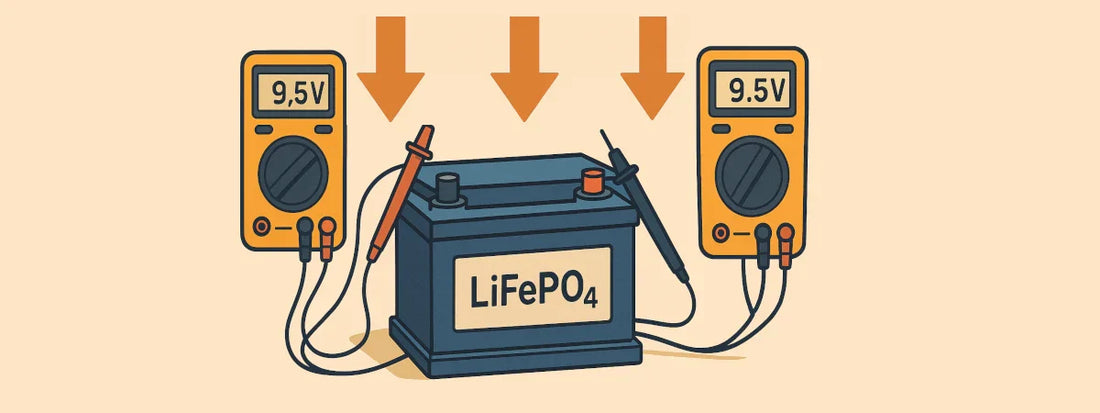
LiFePO4 Under Voltage Protection & Recovery
Share

Have you ever experienced the frustration of a dead battery that just won't charge? Understanding under voltage protection could be the key to getting your battery up and running again. Let's dive into what under voltage protection is and how you can troubleshoot your battery to bring it back to life.
What is Under Voltage Protection?
Under voltage protection is a feature designed to prevent lithium batteries from over-discharging, which can lead to permanent damage or even render the battery unusable. When a battery reaches a certain low voltage threshold (usually ~10V for 12.8V batteries), under voltage protection kicks in to cut off the output electronics and protect the battery cells.
It's important to note that if this protection triggers, the battery is in a vulnerable state and should not be left long without attempting to recharge. The longer it is left, the more likely there will be permanent damage. This type of damage isn't covered by most warranties.
How Does Under Voltage Protection Affect Charging?
When under voltage protection is triggered, it causes the battery to show odd/low voltage readings, and many chargers won't detect the battery when connected. This can lead users to believe their battery has a serious problem, or has failed.
It's not that the battery won't accept a charge. The opposite is true in fact! That battery is ready and willing to accept a charge, but modern smart chargers require a voltage to be present for them to detect the battery presence. Without this, the charger won't start outputting charge current.
This can be frustrating, especially when you're relying on your device to function properly. However, there are steps you can take to try and reset the under voltage protection and get your battery to charge again.
How to Reset Under Voltage Protection and Charge Your Battery
You'll need to get the undercharged cell back into a normal voltage range.
One common method to reset under voltage protection is to disconnect the battery from the device and let it sit for a short period of time. This is most effective with batteries that have just triggered UVP recently. Sitting (without any load) can let the battery self-charge a tiny bit and may lift the the cell voltage above the reset threshold. This is a 30-60 minute option. If still not reset, you'll need to try something else.
Bringing the battery inside, or somewhere warm. If the battery is cold, and UVP has been triggered, bringing the battery indoors and warming it up (only normal 20-30°C temperatures, do not heat with tools or flame), will speed up the battery's internal chemical reaction and lift the voltage.
A third option is to get a charger that includes a lithium re-activation (or "wake up") mode. Our HTRC series of chargers include this function. This will usually put the charger into a more "dumb" mode where it just outputs a voltage and the battery can charge the little bit it needs to wake up again. After it wakes up, you can revert to normal charging modes.
If these methods don't work, you may need to consider replacing the battery as it may have been permanently damaged by over-discharging. This is common when a battery is left unattended with a load attached, for extended periods of time. It's always a good idea to consult with a professional or the manufacturer for guidance on the best course of action. Do not force a battery to charge that isn't showing signs of waking up using normal methods.
Conclusion
Understanding under voltage protection is crucial when dealing with a dead battery that won't charge. By knowing how this feature works and how to troubleshoot it, you can increase the chances of reviving your battery and getting your battery back up and running. Remember to always handle batteries with care and follow proper charging practices to avoid potential damage in the future.
HTRC LiFePO Recovery Process:
- Connect charger to battery terminals
- Press & Hold "MODE" button until charger unit begins repeated beeping (24V indicator LED will flash)
- Release "MODE" button, Wait 2-3 seconds
- Press & Hold "MODE" button until charger beeps & clicks to signal it has started 24V Forced charging (This is ok with 12V batteries)
- Wait until voltage display on the charger reads > 10.5 Volts (multiply by 2x, 3x, or 4x for 24/36/48V batteries), or wait about 5 minutes and try moving on to Step 6.
- Disconnect Charger & Then Reconnect Charger to return to normal charging mode.
If charger doesn't work in normal mode, try the process again. If after a few tries, it's still not working, you may have an excessively undercharged battery and should contact support.
Notes:
If the charger beeps (Step 4) and then faults and doesn't charge, there isn't enough load detected to keep it operating. Re-connect the battery to a load (like an inverter with no loads, or a trolling motor on low), and then try again from Step 1. You can disconnect the load (or turn it off) once you reach Step 5.
Both our 10 Amp, and 20 Amp version chargers support this feature.
